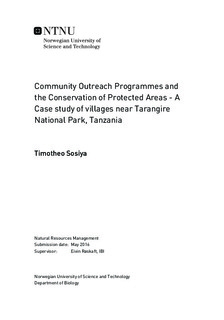Community Outreach Programmes and the Conservation of Protected Areas - A Case study of villages near Tarangire National Park, Tanzania
Master thesis
Permanent lenke
http://hdl.handle.net/11250/2390457Utgivelsesdato
2016Metadata
Vis full innførselSamlinger
- Institutt for biologi [2573]
Sammendrag
Linking conservation of wildlife in and around protected areas (PAs) to community livelihoods surrounding those areas is inevitable for sustainable co-existence between PAs and people. Community Outreach Programs (OP) are believed to be a key strategy across various PAs to achieve such goals. This study aimed at assessing the effectiveness of Community Conservation Programmes (CCP) in sharping local people attitudes towards conservation. Questionnaire survey, Key Person s Interview (KPI) and site visits/photo documentation were used to collect primary data from respondents. Ethnicity, village location and nature of economic activities were used in the selection of villages while respondents were chosen through simple random sampling. Results indicated that the performance of OP and cooperation between park and people is weakening geared by several factors. Benefits rendered to local communities, extent of community participation, distance from the boundary and losses from wildlife have significantly affected the attitudes of local people towards conservation. Support for tourism projects, establishment of Wildlife Management Areas (WMAs) had positive effects while restrictions on resource access, loss from wildlife and low level of community awareness and/or information sharing had negatively affected the program. The participation of local people in OP activities was poor so is their awareness about what the program does in their villages leading to their negativity in supporting conservation. Wildlife induced losses and ineffective management of problem animals negatively affected community attitudes causing retaliatory killings. The loss from wildlife were high in villages close to PA boundary causing unwillingness to report poachers. For sustainable coexistence, the National Park Act needs to be amended so that parks take active participation in handling problem animals and paying consolation scheme. However, improved involvement of local people in project activities, information sharing and collaborative control of problem animals will lead to good neighborhood and increased awareness about OP and subsequently their support for conservation.
